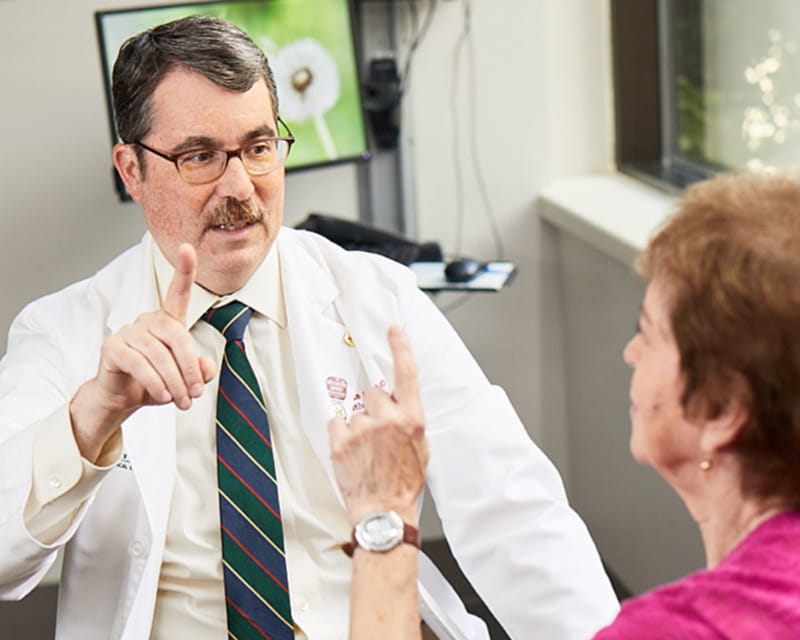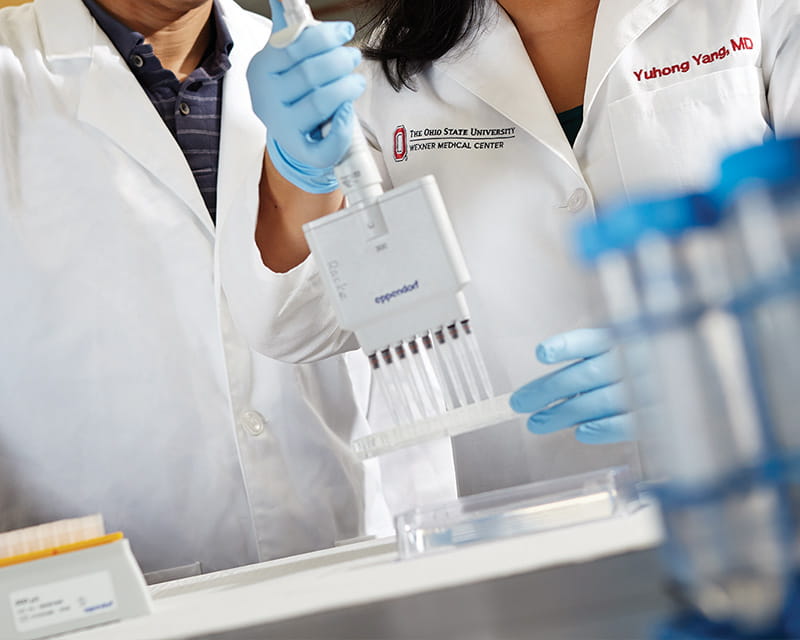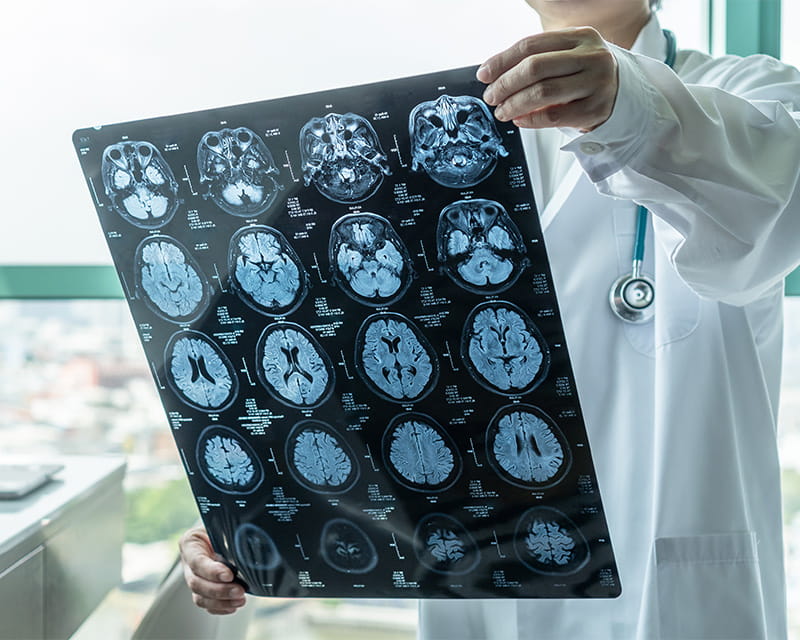
Ohio State researchers identify new biomarkers that differentiate Lewy body dementia from Alzheimer’s and Parkinson’s
 As knowledge of the genetics of spinal muscular atrophy (SMA) and other neuromuscular conditions advances, researchers at The Ohio State University Wexner Medical Center are exploring new treatment options. Their ongoing work is improving the lives of patients.
As knowledge of the genetics of spinal muscular atrophy (SMA) and other neuromuscular conditions advances, researchers at The Ohio State University Wexner Medical Center are exploring new treatment options. Their ongoing work is improving the lives of patients.
The FDA has approved a gene replacement therapy (onasemnogene abeparvovec-xioi) for children under the age of 2, and two gene-modifying therapies (nusinersen and risdiplam) for individuals with SMA of all ages. This has opened the door for similar therapies to be tested in other neuromuscular diseases, such as amyotrophic lateral sclerosis (ALS) and muscular dystrophy.
As these treatments have been used in clinics for a few years, neurologists have gained a better understanding of what’s required. Bakri Elsheikh, MBBS, a clinical professor in the Department of Neurology at The Ohio State University College of Medicine and a neurologist who specializes in neuromuscular medicine, clinical neurophysiology and treating adults with SMA, says gene therapy works best when used in conjunction with standard of care treatment.
“SMA can lead to complications impacting the musculoskeletal, orthopedic, respiratory, gastrointestinal and nutritional systems. That’s why it’s so critical to address these complications in the management plan,” Dr. Elsheikh says.
He goes on to say, “We don’t think these cutting-edge therapies will work on their own. They work hand in hand with a multidisciplinary care approach that focuses on a proactive care model. That is why our team focuses on monitoring and managing the various complications of SMA.”
As Dr. Elsheikh and his colleagues continue their research on SMA, they’ve come to understand that it’s a progressive disease that affects patients of all ages, including adults. While some patients may experience a temporary plateau in their symptoms, the disease ultimately continues to progress.
SMA is classified into two forms based on the timing of onset. Early onset SMA was once fatal for most babies, but today, early therapy facilitated by newborn screenings has led to longer life expectancies for these children. The milder form of SMA, known as late onset, appears later in childhood or early adulthood. With treatment, many individuals with late onset disease, including adults, can experience stabilization and improved motor function.
Gene therapy treatment is groundbreaking for SMA as it improves survival and muscle movement and function.
“The major message is that earlier treatment in the disease course provides the best results, but there is benefit to treatment for all disease stages,” Dr. Elsheikh says.
He manages the Ohio State Wexner Medical Center’s Muscular Dystrophy Association Care Center, Cure SMA Care Center and its electromyography laboratory.
“What we know is that treatment that replaces the missing gene or modifies the existing backup gene can result in improvement or stabilization of a progressive disease,” Dr. Elsheikh says.
Assessing the treatment response of adult patients with SMA can be challenging due to the significant variability in their functional abilities. As such, multiple outcome measures are used to assess motor function and skeletal and respiratory muscle strength. A unique aspect of the medical center’s gene therapy clinical work is the refinement of patient-reported outcome tools to measure treatment response. Clinicians can evaluate patients remotely and still obtain reliable information on their functional abilities using a modified functional rating scale questionnaire developed in the United States and modified at Ohio State. The questionnaire is widely used nationally and internationally.
To understand the mechanisms that led to stabilization and improvement of motor function in individuals with SMA with treatment, Dr. Elsheikh and his team study the role of electrophysiological biomarkers.
Specialized testing is conducted to estimate the number of functioning motor units and the size of a single motor unit response and to evaluate signal transmission at the neuromuscular junction. Additionally, Dr. Elsheikh and colleagues perform decomposition electromyography testing as a biomarker to learn more about motor neuron-firing behaviors.
“This allows us to understand the different mechanisms that impact the motor function in individuals with SMA and the effect of SMA-restoring therapies on these mechanisms and to shed light on potential synergistic therapeutic strategies,” Dr. Elsheikh says.
Dr. Elsheikh and his colleagues have found that adult patients with SMA also have a neuromuscular junction transmission defect that’s not fully corrected with the use of nusinersen. This led to collaboration with international partners to conduct studies at the Ohio State Wexner Medical Center researching certain compounds that might improve neuromuscular junction transmissions.
Currently, there are several ongoing studies that aim to investigate the potential benefits of combining SMN-restoring therapies with muscle-enhancing drugs or other medications that target neuromuscular junction transmission defects in individuals with SMA.
“Combination treatment therapies are the future of this disease,” Dr. Elsheikh says. “In addition to strategies replacing or improving the correct gene to make the protein that is deficient in SMA, we are also looking for an additive effect by enhancing the muscle or neuromuscular junction transmission.”
When the Food and Drug Administration (FDA) approved the first disease-modifying treatment for SMA in adults, studies of the medications had only been conducted on children aged 12 or younger. As adult patients began taking the treatments, researchers used real-world data to study the medication’s effects in adults.
Despite the significant progress, more information is still needed, Dr. Elsheikh says. For instance, there currently are no head-to-head studies comparing the different gene-modifying treatments for adult patients. Such data can aid in making informed decisions in clinical settings and provide guidance for individualized medical care, such as determining which medicine to start with and when to consider switching between FDA-approved treatments.
“There is still work to be done,” Dr. Elsheikh says. “We need to optimize outcome measures, biomarkers, therapies and treatments for different spectrums of the disease.”

Ohio State researchers identify new biomarkers that differentiate Lewy body dementia from Alzheimer’s and Parkinson’s

Biomarker breakthroughs at Ohio State transform disease diagnosis, predictability and treatment

The Ohio State University Wexner Medical Center pushes boundaries for neurological care